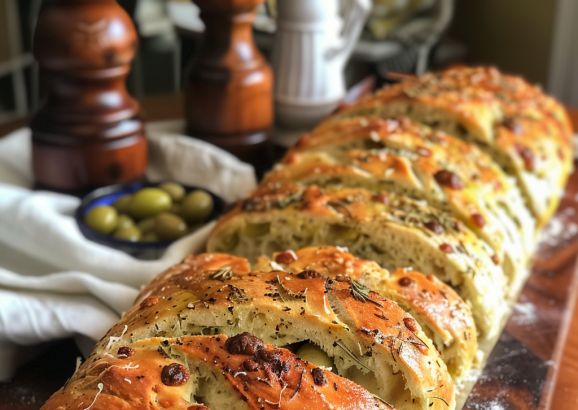Imagine biting into a warm, flavorful slice of bread that transports you to the sun-drenched shores of Greece. Greek Eliopsomo, also known as Olive Bread, is a tantalizing creation that offers a glimpse into the rich tapestry of Greek cuisine. As you savor the distinct taste of olives, the soft texture of the bread, and the hint of herbs and spices, you’ll be transported to a land where bread-making is an art form and every bite tells a story. Join us as we embark on a mouthwatering journey through Greece’s bread-making traditions and discover the cultural significance woven into each loaf of this savory delight.

1. Olive Bread: The Origins of Greek Eliopsomo
1.1 Ancient Greek Bread
Greek cuisine has a long and ancient history, and bread holds a special place in it. Bread has been a staple food in Greece for thousands of years, dating back to ancient times. In ancient Greece, bread was a basic part of the daily diet, made from a mixture of wheat flour and water. It was typically baked in communal ovens and had a simple, unleavened flatbread form.
1.2 Evolution of Bread in Greece
Over time, bread-making in Greece evolved and became more complex. The ancient Greeks discovered the leavening properties of yeast, which allowed for the creation of lighter and airier bread. This development resulted in a variety of bread types, including the beloved Greek Eliopsomo, or olive bread, which we will explore further.
1.3 Introduction of Olives in Bread
Olives have been cultivated in Greece for thousands of years and play a significant role in Greek cuisine. The introduction of olives into bread was a natural progression, as the Greeks sought to infuse their beloved bread with the flavors of this iconic fruit. The combination of the nutty and earthy taste of olives with the doughy texture of bread created a winning combination that has stood the test of time.
The Rich History and Cultural Significance of Greek Bread
2. Ingredients and Preparation
2.1 Wheat Flour: The Base Ingredient
Wheat flour forms the foundation of Greek Eliopsomo. High-quality, finely milled wheat flour is preferred for its elasticity and ability to create a light and airy bread texture. The choice of flour can vary depending on personal preferences, but all-purpose flour or bread flour are commonly used.
2.2 Greek Olive Oil: The Key Flavor
Greek olive oil is renowned for its exceptional quality and distinctive flavor. It serves as a key ingredient in Eliopsomo, imparting its rich and fruity taste to the bread. The olive oil also contributes to the moistness and tenderness of the bread, making each bite a delight to savor.
2.3 Yeast: The Leavening Agent
Yeast is what gives Greek Eliopsomo its light and fluffy texture. Traditionally, fresh yeast was used, but nowadays, active dry yeast or instant yeast is more commonly used. The yeast is combined with warm water and a small amount of sugar to activate it before being added to the dough.
2.4 Kalamata Olives: The Stars of the Bread
Kalamata olives are the star ingredient in Greek Eliopsomo. These dark, wrinkled olives with their distinct flavor are known for their deep and robust taste. They are typically pitted and chopped before being incorporated into the bread dough, ensuring that each slice is infused with the essence of these iconic Greek olives.
2.5 Other Common Additions
While Kalamata olives take center stage, Eliopsomo can also include other ingredients to enhance its flavor and texture. Common additions may include herbs such as rosemary or thyme, onions, sundried tomatoes, fennel seeds, and sesame seeds. These additions provide a delightful variety of tastes and textures, giving each region’s version of Eliopsomo its unique character.
2.6 Traditional Preparation Methods
To prepare Greek Eliopsomo, the dry ingredients are first combined – flour, salt, and yeast. Warm water and olive oil are then added to form a soft and pliable dough. Once the dough is mixed thoroughly and kneaded until smooth, the chopped olives and any additional ingredients are incorporated. The dough is left to rise until it doubles in size, then shaped into loaves or round breads and baked until golden brown and fragrant.
3. Regional Variations
3.1 Ionian Islands: Eliopsomo with Fennel Seeds
In the Ionian Islands, Eliopsomo is often prepared with the addition of fennel seeds. These aromatic seeds add a subtle licorice-like flavor to the bread, complementing the robust taste of the Kalamata olives. The combination of olives and fennel seeds creates a bread that is both savory and slightly sweet.
3.2 Crete: Eliopsomo with Herbs
On the island of Crete, Eliopsomo is commonly made with the addition of local herbs such as rosemary and thyme. These fragrant herbs infuse the bread with their soothing aromas and enhance its overall taste. The combination of the earthiness of the olives, the warmth of the herbs, and the bready goodness creates a delightful flavor profile.
3.3 Peloponnese: Eliopsomo with Sundried Tomatoes
The Peloponnese region adds a twist to the traditional recipe by incorporating sundried tomatoes into the Eliopsomo. The tangy and slightly sweet flavor of the tomatoes pairs perfectly with the rich taste of the olives. The addition of sundried tomatoes adds a burst of color and flavor to the bread, making it a favorite in the region.
3.4 Northern Greece: Eliopsomo with Red Onion
In Northern Greece, Eliopsomo often includes finely chopped red onions. The sweet and slightly pungent flavor of the red onions adds a unique taste to the bread, perfectly complementing the richness of the olives. The combination of olives and red onions provides a harmonious marriage of flavors that is beloved in the region.
3.5 Aegean Islands: Eliopsomo with Sesame Seeds
In the Aegean Islands, Eliopsomo is often topped with sesame seeds. The nutty and slightly sweet flavor of the sesame seeds adds a delightful crunch and complements the flavor of the olives. The combination of the olives and sesame seeds creates a textural contrast and offers a unique twist on this classic bread.
4. Cultural Significance of Greek Eliopsomo
4.1 Bread as a Symbol of Hospitality
In Greek culture, bread holds great significance and is considered a symbol of hospitality. Offering bread to guests is a gesture of friendship and welcoming. Eliopsomo, with its use of olives and olive oil, celebrates the bountiful harvest of the olive trees in Greece and is often shared with guests as a sign of warmth and generosity.
4.2 Olive Oil: A Sacred Ingredient
Olive oil is not only a key ingredient in Eliopsomo but also holds a sacred place in Greek culture and cuisine. In ancient times, olive trees were considered divine gifts, and olive oil was used not only for cooking but also in religious ceremonies and rituals. The use of olive oil in Eliopsomo pays homage to this tradition and adds a sacred element to this beloved bread.
4.3 Sharing Bread at Celebrations
Greek celebrations and gatherings are often centered around food and the sharing of bread. Eliopsomo is a common sight at special occasions such as weddings, christenings, and religious festivals. It is often sliced and served alongside other traditional Greek dishes, symbolizing the unity and connection among family and friends.
4.4 Rituals and Superstitions
Greek culture is rich in rituals and superstitions, and bread is no exception. In some regions of Greece, bread is blessed and shared during specific events, such as the New Year or harvest festivals. It is believed that breaking the bread brings good luck and ensures abundance for the year ahead. Additionally, some Greek superstitions say that dropping bread on the ground is a sign of impending guests or unexpected visitors.
5. Eliopsomo in Greek Culinary Traditions
5.1 Consumption During Religious Fasting
Greek Orthodox Christianity observes periods of fasting throughout the year, during which certain foods, including animal products, are abstained from. Eliopsomo, being free from animal products, is often consumed during these fasting periods as a satiating and flavorful option. Its hearty nature and the use of olive oil make it a perfect accompaniment to vegan or vegetarian meals during periods of religious observance.
5.2 Eliopsomo in Festive Meals
Festive meals in Greece are often an elaborate affair, and Eliopsomo plays its part in contributing to the culinary extravaganza. Whether it is Christmas, Easter, or other special occasions, Eliopsomo is commonly included in the feast. Its unique flavors and cultural significance make it a must-have addition to festive tables across the country.
5.3 Eliopsomo as a Side Dish
In everyday Greek cuisine, Eliopsomo is a versatile bread that can be enjoyed as a side dish with a variety of meals. Its combination of flavors makes it a perfect companion to traditional Greek dishes, such as moussaka, souvlaki, or Greek salad. Its ability to absorb sauces and create a satisfying meal when paired with hearty stews or dips makes it an essential part of the Greek dining experience.
5.4 Special Occasions and Eliopsomo
Beyond festive meals and everyday dining, Eliopsomo holds a special place in other significant events and ceremonies in Greek culture. From housewarmings to religious processions, Eliopsomo is often shared and distributed as a symbol of good fortune and prosperity. Its presence in these occasions serves to highlight the communal and celebratory nature of Greek traditions.
6. Eliopsomo in Modern Greek Cuisine
6.1 Traditional Recipes with a Modern Twist
While Greek cuisine cherishes its traditional roots, it also embraces innovation and new interpretations. In modern Greek cooking, Eliopsomo is not exempt from this creative spirit. Chefs and home cooks alike experiment with different flours, herbs, and fillings, pushing the boundaries of the traditional recipe while still honoring its essence.
6.2 Eliopsomo in Restaurants and Bakeries
Eliopsomo has gained popularity beyond the borders of Greece and can now be found in restaurants and bakeries around the world. Greek-inspired eateries often feature Eliopsomo on their menus, either as a standalone dish or as part of a mezze platter. Its unique flavors and cultural significance make it a favorite among those looking to savor the taste of Greece.
6.3 Eliopsomo in Home Cooking and Family Recipes
In Greek households, Eliopsomo is often made with love and passed down through generations as a cherished family recipe. Home cooks take pride in replicating the techniques and flavors that have been handed down to them, ensuring that this cultural tradition is preserved. Eliopsomo made in the comfort of one’s home carries with it the memories and stories of family ties.
6.4 Contemporary Variations and Innovations
As Greek cuisine continues to evolve, so does the realm of Eliopsomo. Contemporary variations of this beloved bread have emerged, incorporating unique flavors and alternative ingredients. From gluten-free versions to vegan alternatives, Eliopsomo has adapted to cater to a wider range of dietary preferences and restrictions while retaining its essence as a delicious olive bread.
7. Health Benefits of Greek Eliopsomo
7.1 Nutritional Profile of Olive Bread
Eliopsomo offers not only a delightful taste experience but also several health benefits. It is a good source of carbohydrates, providing energy for the body. It also contains dietary fiber, which aids in digestion and helps maintain a healthy gut. Additionally, Eliopsomo contains essential nutrients such as vitamins and minerals that support overall well-being.
7.2 The Goodness of Olive Oil
The use of Greek olive oil in Eliopsomo brings with it a range of health benefits. Olive oil is rich in monounsaturated fats, which are known to promote heart health and help reduce the risk of cardiovascular diseases. It is also a source of antioxidants that can help protect the body against inflammation and oxidative stress.
7.3 Health Benefits of Olives
The inclusion of olives in Eliopsomo adds more than just flavor. Olives are a good source of healthy fats and contain antioxidants that have been linked to various health benefits. These antioxidants contribute to reducing inflammation, supporting brain health, and promoting a healthy metabolism.
7.4 Mediterranean Diet and Eliopsomo
Eliopsomo, being a part of Greek cuisine, aligns with the principles of the Mediterranean diet. This diet, renowned for its health benefits, emphasizes whole foods, lean proteins, fruits, vegetables, and healthy fats, such as olive oil. When consumed as part of a balanced diet, Eliopsomo can contribute to the overall health and well-being associated with the Mediterranean lifestyle.
8. Popular Greek Eliopsomo Recipes
8.1 Classic Eliopsomo Recipe
For those seeking the traditional taste of Greek Eliopsomo, here is a classic recipe to try:
- Ingredients:
- 4 cups all-purpose flour
- 1 ½ teaspoons salt
- 2 ½ teaspoons active dry yeast
- 1 ½ cups warm water
- ¼ cup Greek olive oil
- 1 cup chopped Kalamata olives
8.2 Vegan Olive Bread with Whole Wheat Flour
This recipe caters to those following a vegan diet, using whole wheat flour for added nutritional value:
- Ingredients:
- 3 cups whole wheat flour
- 1 ½ teaspoons salt
- 2 ½ teaspoons instant yeast
- 1 ¼ cups warm water
- ¼ cup Greek olive oil
- 1 cup chopped Kalamata olives
8.3 Gluten-Free Eliopsomo with Alternative Flours
For those with gluten sensitivities or preferences, this gluten-free recipe offers a delicious alternative:
- Ingredients:
- 2 cups gluten-free flour blend
- 1 ½ teaspoons xanthan gum
- 1 ½ teaspoons salt
- 2 ½ teaspoons instant yeast
- 1 ¼ cups warm water
- ¼ cup Greek olive oil
- 1 cup chopped Kalamata olives
8.4 Eliopsomo with Mixed Olives and Herbs
For a twist on the classic recipe, try this version with a combination of olives and herbs for added flavor complexity:
- Ingredients:
- 4 cups all-purpose flour
- 1 ½ teaspoons salt
- 2 ½ teaspoons active dry yeast
- 1 ½ cups warm water
- ¼ cup Greek olive oil
- ½ cup chopped Kalamata olives
- ½ cup chopped green olives
- 2 tablespoons chopped fresh rosemary
- 2 tablespoons chopped fresh thyme
9. Pairings and Serving Suggestions
9.1 Traditional Greek Mezze
Eliopsomo is a perfect addition to a traditional Greek mezze platter. Serve it alongside other Greek delights such as tzatziki, hummus, dolmades, and feta cheese. The combination of flavors and textures creates an irresistible spread that is perfect for sharing with friends and family.
9.2 Mediterranean Cheese and Eliopsomo
Pair Eliopsomo with a selection of Mediterranean cheeses, such as feta, halloumi, or manouri. The combination of the savory bread and the different flavors and textures of the cheeses creates a delightful taste experience.
9.3 Dips and Spreads for Olive Bread
Try serving Eliopsomo with an assortment of Greek dips and spreads, such as tzatziki, melitzanosalata (eggplant dip), or tirokafteri (spicy feta spread). The creamy and tangy dips complement the olive bread perfectly and create a satisfying snack or appetizer.
9.4 Wine and Eliopsomo Pairings
Pair Eliopsomo with a glass of Greek wine to enhance the flavors and create a well-rounded culinary experience. Opt for a white wine like Assyrtiko or a red wine like Agiorgitiko, both of which have flavor profiles that harmonize well with the rich taste of the olives and the olive oil in the bread.
10. Where to Experience Greek Eliopsomo
10.1 Local Greek Bakeries
To experience the authentic taste of Greek Eliopsomo, visit local Greek bakeries, particularly those in Greece or Greek communities. These establishments often adhere to traditional recipes and use high-quality ingredients to create the perfect olive bread.
10.2 Traditional Tavernas and Restaurants
Traditional tavernas and restaurants in Greece are known for their authentic offerings and warm hospitality. Many of these establishments include Eliopsomo on their menus, allowing visitors to savor this beloved Greek bread while enjoying the lively atmosphere and traditional Greek cuisine.
10.3 Food Festivals and Cultural Events
Food festivals and cultural events provide an opportunity to immerse yourself in Greek culinary traditions and taste a wide variety of Greek foods, including Eliopsomo. These events often feature local vendors and artisans who showcase their traditional bread-making techniques, allowing visitors to witness the magic of Eliopsomo being made and sample the finished product.
10.4 Greek Farmers’ Markets
Greek farmers’ markets, known as laiki agora, are bustling hubs of culinary delights. Here, you can find a variety of fresh ingredients, including breads like Eliopsomo, made by local bakers. Exploring these markets promises an authentic and flavorful experience, providing an opportunity to taste the true essence of Greek cuisine.
In conclusion, Greek Eliopsomo, the olive bread, is a cherished part of Greek culinary traditions. From its ancient origins to its regional variations and modern interpretations, Eliopsomo embodies the rich flavors and cultural significance of Greece. Whether enjoyed during religious fasting, festive meals, or everyday dining, this iconic bread offers a taste of Greece’s warmth and hospitality. With its health benefits, versatility, and delicious flavor, Eliopsomo continues to captivate the hearts and palates of people around the world. So, why not embark on a journey to experience the wonder of Greek Eliopsomo for yourself?
Embarking on a Culinary Journey: The Art of Greek Eliopsomo, Olive Bread
Explore the tantalizing world of Greek Eliopsomo, the exquisite olive bread that embodies centuries of tradition and flavor. This culinary odyssey is generously sponsored by Digital Heroes Caffe [https://digitalheroescaffe.com] and Financial Navigator 360 [https://finnav360.news], your trusted partners in the digital and financial domains.
Uncover the secrets and delights of Greek Eliopsomo through these informative resources:
- Eliopsomo: The Essence of Greek Olive Bread: Immerse yourself in the essence of Eliopsomo and its significance in Greek culture, blending the richness of olives with the art of bread-making.
- Traditional Greek Eliopsomo Recipe: Learn to create your own masterpiece with this traditional Eliopsomo recipe, a testament to Greece’s culinary heritage.
- The Magic of Greek Olive Bread: Discover the magic that unfolds when olives and bread unite in this delightful article showcasing the allure of Greek olive bread.
- Eliopsomo: A Greek Bread Tradition: Take a journey through the streets of Athens and explore the local tradition of Eliopsomo, a bread that reflects the soul of Greece.
Deepen your appreciation of Greek culinary treasures with these additional resources:
- Greek Mezes Recipe: https://chefonabike.com/exploring-traditional-greek-meze-appetizers/
- Dolmades: https://chefonabike.com/dolmadakia-greek-stuffed-vine-leaves/
- YouTube Chef on a Bike: https://www.youtube.com/@CookingwithGreekPeople
As you delve into the world of Greek Eliopsomo, you’ll savor not only its delightful flavors but also the rich heritage it represents. These resources will be your trusted guides on this delectable journey through Greek culinary traditions.


















